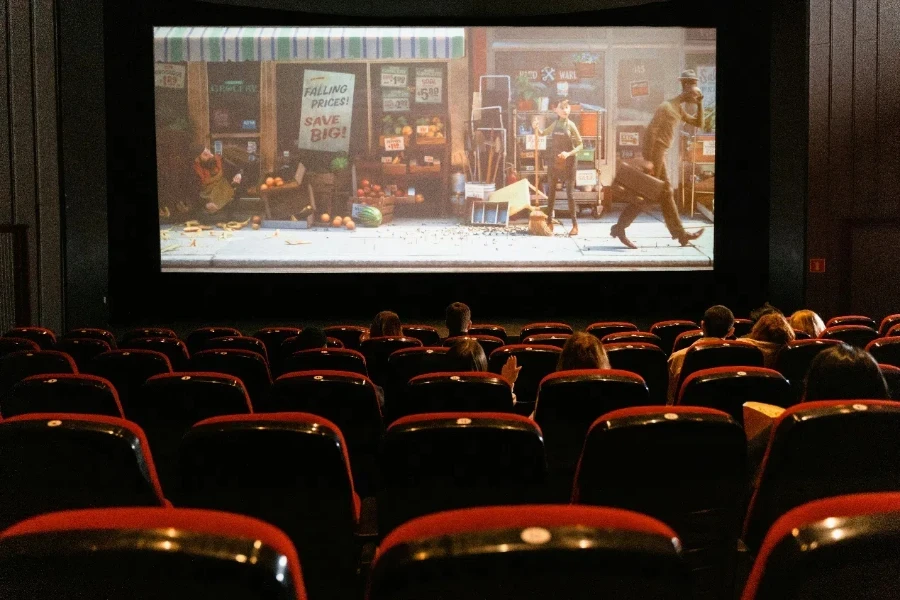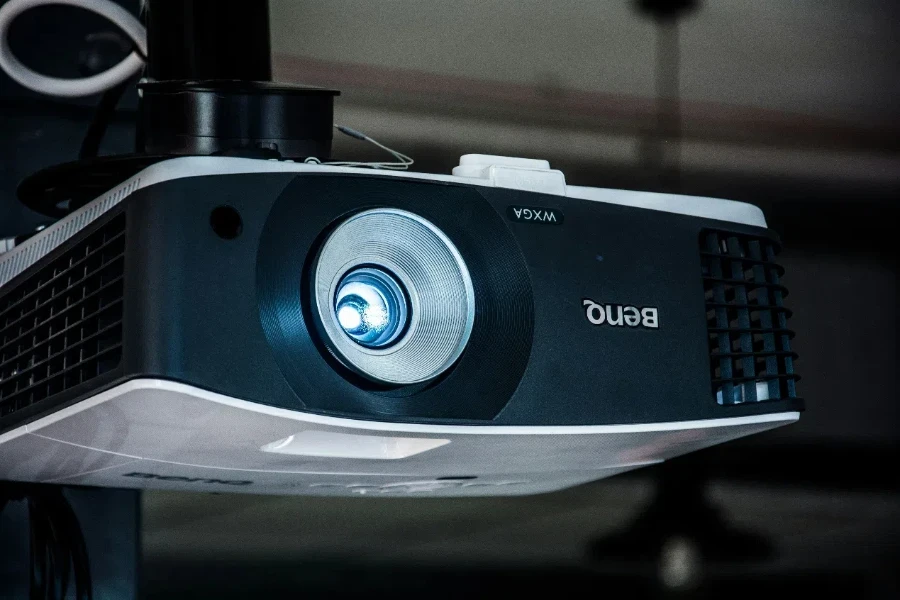Die Nachfrage nach hochwertigen Heimkinoerlebnissen steigt und bis 2025 wird es bedeutende Fortschritte in der Projektortechnologie geben. Dieser Artikel befasst sich mit den wesentlichen Merkmalen wie Auflösung, Helligkeit und Konnektivität, um professionellen Käufern eine fundierte Entscheidung zu ermöglichen.
Table of Contents:
– Den Heimkino-Markt verstehen
– Wachstumstreiber bei Heimkino-Projektoren
– Wichtige Funktionen, die bei Filmprojektoren zu berücksichtigen sind
– Arten von Projektoren für Heimkino
– Tipps zur Installation und Einrichtung
Den Heimkino-Markt verstehen

Wichtige Marktstatistiken
Der Markt für Heimkinoprojektoren hat ein deutliches Wachstum erlebt. Der weltweite Markt für fortschrittliche Kinoprojektoren wächst von 2.67 Milliarden USD im Jahr 2023 auf 2.81 Milliarden USD im Jahr 2024. Dieser Markt wird voraussichtlich seinen Aufwärtstrend fortsetzen und bis 3.88 2030 Milliarden USD erreichen, was einer durchschnittlichen jährlichen Wachstumsrate von 5.47 % entspricht. Die Nachfrage nach hochwertigen Kinoerlebnissen zu Hause treibt dieses Wachstum an, wobei die Verbraucher zunehmend nach Projektoren suchen, die 4K- und 8K-Auflösung, 3D-Projektionsfunktionen und High Dynamic Range (HDR)-Bildgebung bieten.
Technologisch führen Digital Light Processing (DLP)-Projektoren den Markt an. Das Marktvolumen für DLP-Projektoren wird auf 5.81 Milliarden USD im Jahr 2024 geschätzt und soll bis 8.25 2029 Milliarden USD erreichen, was einer durchschnittlichen jährlichen Wachstumsrate von 7.24 % entspricht. Der Markt für Projektionsleinwände, ein wesentlicher Bestandteil von Heimkino-Setups, wächst ebenfalls, von 2.62 Milliarden USD im Jahr 2023 auf 2.74 Milliarden USD im Jahr 2024, mit einer erwarteten durchschnittlichen jährlichen Wachstumsrate von 5.01 %, und soll bis 3.69 2030 Milliarden USD erreichen.
Verbraucherpräferenzen und Trends
Die Verbraucherpräferenzen im Heimkinomarkt verschieben sich in Richtung höherer Auflösung und besserer Bildqualität. Die Nachfrage nach 4K-Projektoren ist besonders stark, getrieben durch die zunehmende Verfügbarkeit von 4K-Inhalten und den Wunsch nach einem immersiven Seherlebnis. Das Segment der 4K-Auflösung wird im Analysezeitraum voraussichtlich mit einer durchschnittlichen jährlichen Wachstumsrate von 3.1 % wachsen, was diesen Trend widerspiegelt.
Ein weiterer wichtiger Trend ist die wachsende Beliebtheit von Laserprojektoren, die im Vergleich zu herkömmlichen lampenbasierten Projektoren eine bessere Helligkeit, Farbgenauigkeit und längere Lebensdauer bieten. Der Markt für Laserprojektoren soll von 13.766 Milliarden USD im Jahr 2022 auf 21.976 Milliarden USD im Jahr 2029 wachsen, was einer durchschnittlichen jährlichen Wachstumsrate von 6.91 % entspricht. Verbraucher bevorzugen auch tragbare Projektoren, die Flexibilität und Komfort bieten. Der globale Markt für tragbare Projektoren soll bis 2.1 2029 Milliarden USD erreichen und mit einer durchschnittlichen jährlichen Wachstumsrate von 4.4 % wachsen.
Wachstumstreiber bei Heimkino-Projektoren

Technologische Fortschritte
Technologische Fortschritte sind ein wichtiger Wachstumstreiber im Markt für Heimkinoprojektoren. Innovationen in der Projektionstechnologie, wie die Entwicklung von Projektoren mit 4K- und 8K-Auflösung, haben das Seherlebnis deutlich verbessert. Diese Projektoren bieten schärfere Bilder, lebendigere Farben und mehr Details, was sie für Heimkino-Enthusiasten äußerst attraktiv macht.
Laserprojektoren sind ein weiterer Bereich des technologischen Fortschritts. Sie bieten eine höhere Helligkeit und Farbgenauigkeit und ihre längere Lebensdauer reduziert den Bedarf an häufigen Austauschvorgängen. Die Einführung der RGB-Lasertechnologie, die 100 % BT.2020-Farbkonformität bietet, ist eine bemerkenswerte Entwicklung. Der tragbare RGB-Laserprojektor M10 von ViewSonic beispielsweise, der im November 2023 auf den Markt kam, ist ein kompaktes Gerät, das vollständig dem 100 % BT.2020-Standard entspricht und eine überragende Bildqualität bietet.
Steigende Nachfrage nach Home-Entertainment
Die steigende Nachfrage nach Home-Entertainment ist ein weiterer wichtiger Wachstumstreiber. Die COVID-19-Pandemie hat diesen Trend beschleunigt, da immer mehr Verbraucher in Heimkino-Setups investieren, um Filme, Sport und Spiele zu Hause zu genießen. Auch der Aufstieg der Streaming-Dienste hat zu dieser Nachfrage beigetragen, da die Verbraucher nach qualitativ hochwertigen Seherlebnissen für ihre Lieblingsinhalte suchen.
Der Markt für Heimkinoprojektoren dürfte deutlich wachsen, angetrieben durch den steigenden Trend zu Streaming-Diensten, Gaming und Heimkinos. Das Segment Unterhaltungselektronik dürfte im Jahr 2024 den größten Marktanteil auf dem Markt für tragbare Projektoren halten, was die wachsende Nachfrage nach hochwertigen Projektionslösungen für die Heimunterhaltung widerspiegelt.
Auswirkungen von Streaming-Diensten
Streaming-Dienste haben den Markt für Heimkinoprojektoren stark beeinflusst. Die Verfügbarkeit hochwertiger Inhalte auf Plattformen wie Netflix, Amazon Prime und Disney+ hat die Nachfrage nach Projektoren erhöht, die ein beeindruckendes Seherlebnis bieten können. Verbraucher suchen nach Projektoren, die 4K- und HDR-Inhalte unterstützen, was diese Streaming-Dienste bieten.
Die Integration intelligenter Funktionen in Projektoren, wie integrierte Streaming-Apps und drahtlose Konnektivität, hat die Nachfrage weiter angekurbelt. So ist beispielsweise der im November 620 auf den Markt gebrachte Smart Projector EH2022 von BenQ für Unternehmensumgebungen konzipiert, spricht mit seinen fortschrittlichen Anwendungen und Sicherheitsprotokollen aber auch Heimkino-Enthusiasten an. Es wird erwartet, dass der Projektormarkt weiter wachsen wird, da Streaming-Dienste ihre Inhaltsbibliotheken erweitern und immer mehr Verbraucher nach hochwertigen Home-Entertainment-Lösungen suchen.
Wichtige Funktionen, die bei Filmprojektoren zu berücksichtigen sind

Auflösung und Bildqualität
Bei der Auswahl eines Filmprojektors sind Auflösung und Bildqualität von größter Bedeutung. High-Definition-Projektoren (HD) bieten normalerweise eine Auflösung von 1080p, während 4K-Projektoren mit 3840 x 2160 Pixeln noch mehr Details liefern. Für ein optimales Seherlebnis sollten Sie Projektoren mit HDR-Unterstützung (High Dynamic Range) in Betracht ziehen, die Farbgenauigkeit und Kontrast verbessert. Suchen Sie außerdem nach Projektoren mit hoher Farbraumabdeckung, wie DCI-P3, um lebendige und lebensechte Bilder zu gewährleisten.
Helligkeits- und Kontrastverhältnis
Die in Lumen gemessene Helligkeit bestimmt, wie gut ein Projektor bei unterschiedlichen Lichtverhältnissen funktioniert. Für Heimkino-Setups wird für dunkle Räume ein Projektor mit mindestens 2,000 Lumen empfohlen, während 3,000 Lumen oder mehr für Räume mit Umgebungslicht ideal sind. Das Kontrastverhältnis, der Unterschied zwischen den dunkelsten und hellsten Teilen eines Bildes, ist ebenfalls entscheidend. Ein höheres Kontrastverhältnis, beispielsweise 100,000:1, sorgt für tiefere Schwarztöne und detailliertere Schatten und verbessert so das Gesamtbilderlebnis.
Projektionsentfernung und Bildschirmgröße
Die Projektionsdistanz bezeichnet den Abstand zwischen Projektor und Leinwand, der sich auf die Bildgröße auswirkt. Kurzdistanzprojektoren können große Bilder aus kurzer Entfernung erzeugen und sind daher für kleine Räume geeignet. Ultrakurzdistanzprojektoren können nur wenige Zentimeter von der Leinwand entfernt aufgestellt werden und bieten so Flexibilität bei der Platzierung. Überlegen Sie sich, welche Leinwandgröße Sie wünschen und stellen Sie sicher, dass das Projektionsverhältnis des Projektors zu den Abmessungen Ihres Raums passt. Ein Projektionsverhältnis von 1.5:1 bedeutet beispielsweise, dass der Projektor pro Fuß Leinwandbreite 1.5 Fuß entfernt stehen muss.
Connectivity-Optionen
Moderne Projektoren verfügen über verschiedene Anschlussmöglichkeiten für verschiedene Geräte. HDMI-Anschlüsse sind für den Anschluss von Blu-ray-Playern, Spielekonsolen und Streaming-Geräten unerlässlich. Einige Projektoren bieten auch drahtlose Konnektivität wie WLAN und Bluetooth, um Inhalte direkt von Smartphones oder Tablets zu streamen. Darüber hinaus können USB-Anschlüsse nützlich sein, um Mediendateien von externen Laufwerken abzuspielen. Stellen Sie sicher, dass der Projektor die erforderlichen Ein- und Ausgänge für Ihr Setup unterstützt.
Lampenlebensdauer und Wartung
Die Lampenlebensdauer ist ein entscheidender Faktor für die langfristigen Kosten und den Wartungsaufwand eines Projektors. Herkömmliche Lampen halten normalerweise zwischen 2,000 und 5,000 Stunden, während LED- und Laserprojektoren bis zu 20,000 Betriebsstunden bieten. Erwägen Sie Projektoren mit Eco-Modus-Einstellungen, die die Lampenlebensdauer durch Reduzierung der Helligkeit verlängern können. Regelmäßige Wartung, wie z. B. das Reinigen von Filtern und Belüftungsöffnungen, ist unerlässlich, um optimale Leistung und Langlebigkeit sicherzustellen. Einige Projektoren verfügen auch über leicht austauschbare Lampen, wodurch Ausfallzeiten und Wartungskosten reduziert werden.
Arten von Projektoren für Heimkino

LCD-Projektoren
LCD-Projektoren (Liquid Crystal Display) verwenden drei separate LCD-Panels, um rotes, grünes und blaues Licht zu erzeugen. Diese Technologie bietet hervorragende Farbgenauigkeit und Helligkeit und ist daher ideal für Heimkino. LCD-Projektoren sind für ihre scharfen und lebendigen Bilder bekannt, mit minimalem Regenbogeneffekt im Vergleich zu DLP-Projektoren. Sie müssen jedoch möglicherweise regelmäßig gewartet werden, um Staubablagerungen auf den LCD-Panels zu verhindern, die die Bildqualität beeinträchtigen können.
DLP-Projektoren
DLP-Projektoren (Digital Light Processing) verwenden ein digitales Mikrospiegelgerät (DMD), um Licht zu reflektieren und Bilder zu erzeugen. Sie sind für ihre hohen Kontrastverhältnisse und ihre flüssige Bewegungssteuerung bekannt und eignen sich daher für rasante Actionfilme und Sportereignisse. DLP-Projektoren sind im Allgemeinen kompakter und leichter als LCD-Projektoren. Einige Benutzer bemerken jedoch möglicherweise einen Regenbogeneffekt, bei dem kurze Farbblitze auftreten, insbesondere in kontrastreichen Szenen.
LED-Projektoren
LED-Projektoren verwenden Leuchtdioden als Lichtquelle und bieten gegenüber herkömmlichen Projektoren mit Lampen mehrere Vorteile. Sie haben eine längere Lebensdauer, die oft 20,000 Stunden übersteigt, und erfordern weniger Wartung. LED-Projektoren sind außerdem energieeffizienter und erzeugen weniger Wärme, wodurch sie im Betrieb leiser sind. Obwohl sie möglicherweise nicht die gleiche Helligkeit wie Projektoren mit Lampen erreichen, sind sie ideal für dunkle Raumumgebungen und bieten eine hervorragende Farbgenauigkeit.
Laserprojektoren
Laserprojektoren verwenden Laserdioden zur Lichterzeugung und bieten eine überragende Helligkeit und Farbleistung. Sie haben eine lange Lebensdauer von oft bis zu 30,000 Stunden und erfordern nur minimale Wartung. Laserprojektoren können höhere Helligkeitsstufen erreichen und eignen sich daher für Räume mit Umgebungslicht. Sie bieten außerdem eine über die Zeit gleichbleibende Leistung ohne Verschlechterung der Bildqualität. Laserprojektoren sind zwar tendenziell teurer als andere Typen, aber ihre langfristigen Vorteile können die anfängliche Investition rechtfertigen.
Tipps zur Installation und Einrichtung

Raumgröße und -aufteilung
Die Größe und Aufteilung Ihres Raums spielen eine entscheidende Rolle für die Leistung des Projektors. Messen Sie den Abstand zwischen Projektor und Leinwand, um das geeignete Projektionsverhältnis zu bestimmen. Stellen Sie sicher, dass genügend Platz für eine ausreichende Belüftung vorhanden ist, um eine Überhitzung zu vermeiden. Überlegen Sie sich die Sitzordnung, um allen Zuschauern einen optimalen Betrachtungswinkel zu bieten. Steuern Sie außerdem das Umgebungslicht mithilfe von Verdunkelungsvorhängen oder Jalousien, um die Bildqualität zu verbessern.
Montageoptionen
Projektoren können an der Decke montiert, auf einem Regal platziert oder auf einem Tisch aufgestellt werden. Deckenhalterungen ermöglichen eine saubere und unauffällige Installation, bei der der Projektor nicht im Weg ist. Stellen Sie sicher, dass die Halterung mit dem Gewicht und der Größe Ihres Projektors kompatibel ist. Tischaufstellungen sind flexibler und tragbarer, benötigen jedoch möglicherweise mehr Platz. Verwenden Sie verstellbare Halterungen, um die Position des Projektors zu optimieren und die gewünschte Bildausrichtung zu erreichen.
Soundsystem-Integration
Die Integration eines Soundsystems in Ihr Projektor-Setup verbessert das gesamte Kinoerlebnis. Erwägen Sie die Verwendung eines Surround-Sound-Systems mit mehreren Lautsprechern für ein beeindruckendes Klangerlebnis. Positionieren Sie die Lautsprecher strategisch im Raum, um eine ausgewogene Klangbühne zu schaffen. Stellen Sie sicher, dass der Projektor über die erforderlichen Audioausgänge wie HDMI ARC oder optisch verfügt, um eine Verbindung zu Ihrem Soundsystem herzustellen. Drahtlose Soundsysteme können auch Kabelsalat reduzieren und die Installation vereinfachen.
Fazit
Bei der Auswahl des richtigen Filmprojektors müssen verschiedene technische Aspekte berücksichtigt werden, um das beste Seherlebnis zu gewährleisten. Wenn Sie die wesentlichen Funktionen und Typen von Projektoren kennen, können Sie eine fundierte Entscheidung treffen, die Ihren Heimkino-Anforderungen entspricht.





 বাংলা
বাংলা Nederlands
Nederlands English
English Français
Français Deutsch
Deutsch हिन्दी
हिन्दी Bahasa Indonesia
Bahasa Indonesia Italiano
Italiano 日本語
日本語 한국어
한국어 Bahasa Melayu
Bahasa Melayu മലയാളം
മലയാളം پښتو
پښتو فارسی
فارسی Polski
Polski Português
Português Русский
Русский Español
Español Kiswahili
Kiswahili ไทย
ไทย Türkçe
Türkçe اردو
اردو Tiếng Việt
Tiếng Việt isiXhosa
isiXhosa Zulu
Zulu